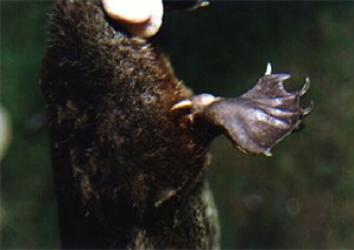Don’t pet the platypus. I know it’s tempting: Given the chance, I’d want to stroke their thick brown fur, tickle those big webbed feet, and pat that funny duck bill. And why not? What harm could come from this cute, egg-laying mammal from eastern Australia?
Plenty. As someone who doesn’t enjoy “long lasting excruciating pain that cannot be relieved with conventional painkillers,” I’d really regret petting a platypus. Especially a male platypus, in late winter, when there’s only one thing on his mind and, even worse, something nasty on his feet.
When British biologist Sir Everard Home got ahold of some platypus specimens in 1801, he told his fellow nerds at the Royal Society how the male specimen had a half-inch long “strong crooked spur” on the heel of each rear foot. The female, however, was spur-free. Home suggested that it “is probably by means of these spurs or hooks, that the female is kept from withdrawing herself in the act of copulation.” A very reasonable suggestion. But a wrong one.
To be fair to Home, he could only study dead platypuses. If Home could have spent a year hanging out with living platypuses in their river homes, he would’ve seen that this “shy, semi-aquatic, mainly nocturnal” mammal is mostly interested in hunting on the river bottom for delicious insect larvae, crayfish, and shrimp. In other words, the platypus is usually an eater, not a lover.

Photo courtest E.Lonnon via Wikimedia Commons
But that changes in late winter: The males’ testes swell, they start fighting over the females, and when they fight, they wrap their legs around their opponent and viciously stab with those sharp spurs. With all the action, Home probably wouldn’t be able to see that the males are also injecting each other with venom. Venom made by their crural glands—a sweat gland co-opted by evolution that swells with about a teaspoon’s volume of venom during mating seasons. But even if he didn’t know about the venom, Home would still see the loser collapse, its limbs paralyzed, while the winner went off to be a lover. To Home’s relief, the loser would eventually recover and stagger (or more likely swim) off. And once mating season’s over, the lovers would go back to being eaters: Their testes go back to normal size, and their crural glands go dormant.
But what would happen if you provoked a randy male’s ire during mating season?
The good news: There’ve been no recorded human fatalities. But there’s also bad news: We know from a few case reports that the randy, angry male can drive his spurs into you so viciously that he’ll “require manual disengagement”—meaning you’ll have to yank his spurs out of your wounds. This would be rather difficult, as you would likely be distracted by pain that was “immediate, sustained, and devastating.” Not even morphine would work against it; the doctors would have to inject local anesthesia to make it stop. But that pain’s just the beginning: Soon you might become nauseated, suffer from cold sweats, and watch as the muscles wasted away in your hand. And if you’re like one unfortunate 57-year-old victim, your hand would stay weak and hypersensitive to pain for up to three months after your “spurring.”
So what’s in platypus venom that makes it so painful?
We’re still figuring that out. With the tools of modern molecular biology, scientists are starting to decipher what makes this “little-studied venom” so painful. In 1995, Australian scientists first isolated the protein culprit that drops the victim’s blood pressure. In 1999, biochemists found another protein that resembled a known neurotoxin. And in 2010, scientists identified 83 genes that might make toxins like those made by spiders, reptiles, and even sea anemones.
But figuring out what’s in platypus venom is more than just biology navel-gazing. For one thing, we don’t have an antivenom for platypus venom—something that the occasional platypus victim would certainly appreciate. And for another, by studying painful platypus venom, scientists could figure out how it overcomes morphine, which could help them design better painkillers.
So unless you’re a brave scientist trying to get some venom to figure out a better painkiller, you shouldn’t pet the platypus. No matter how excruciatingly cute they are.
Read more of Slate’s stories on poisonous animals:
